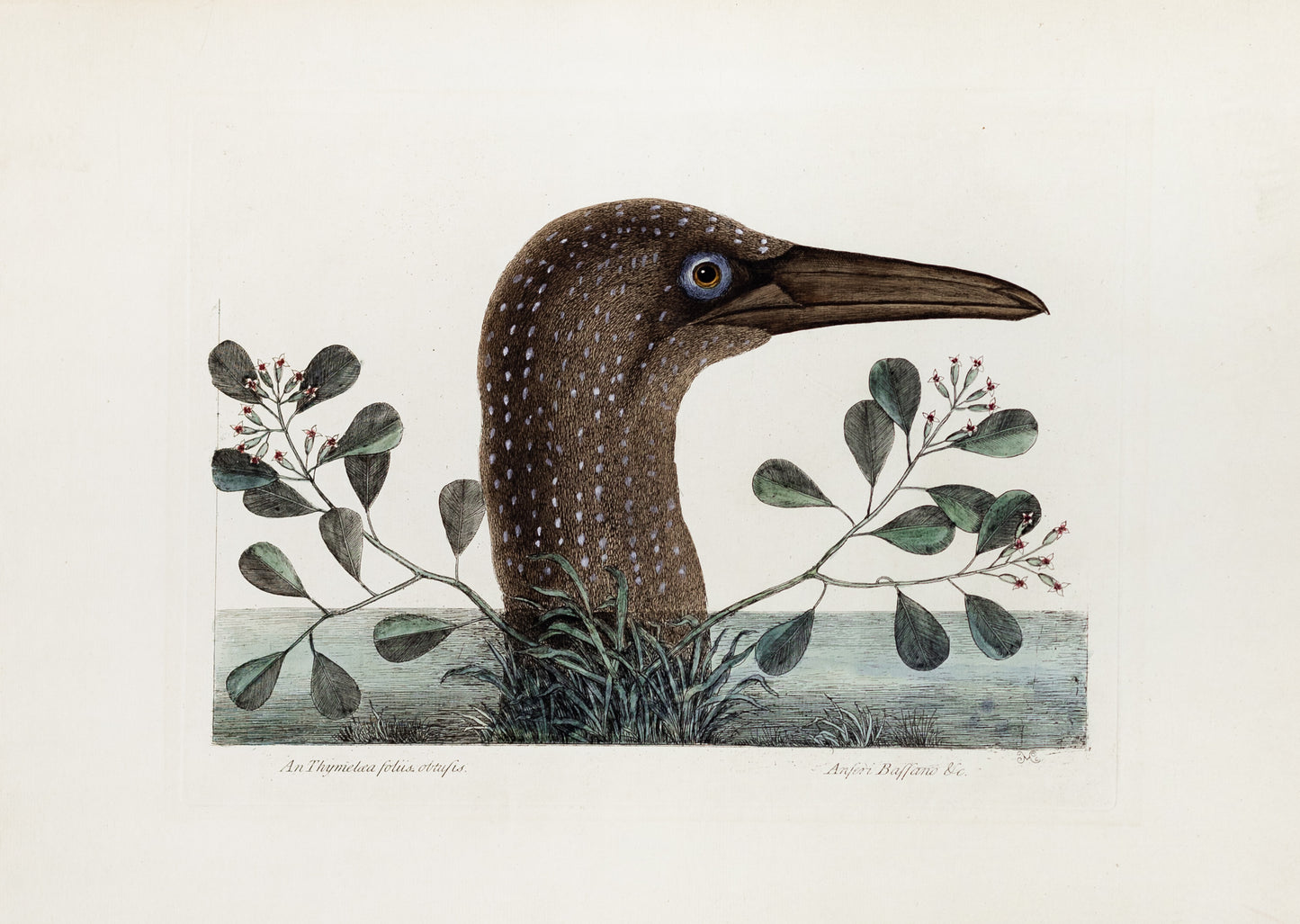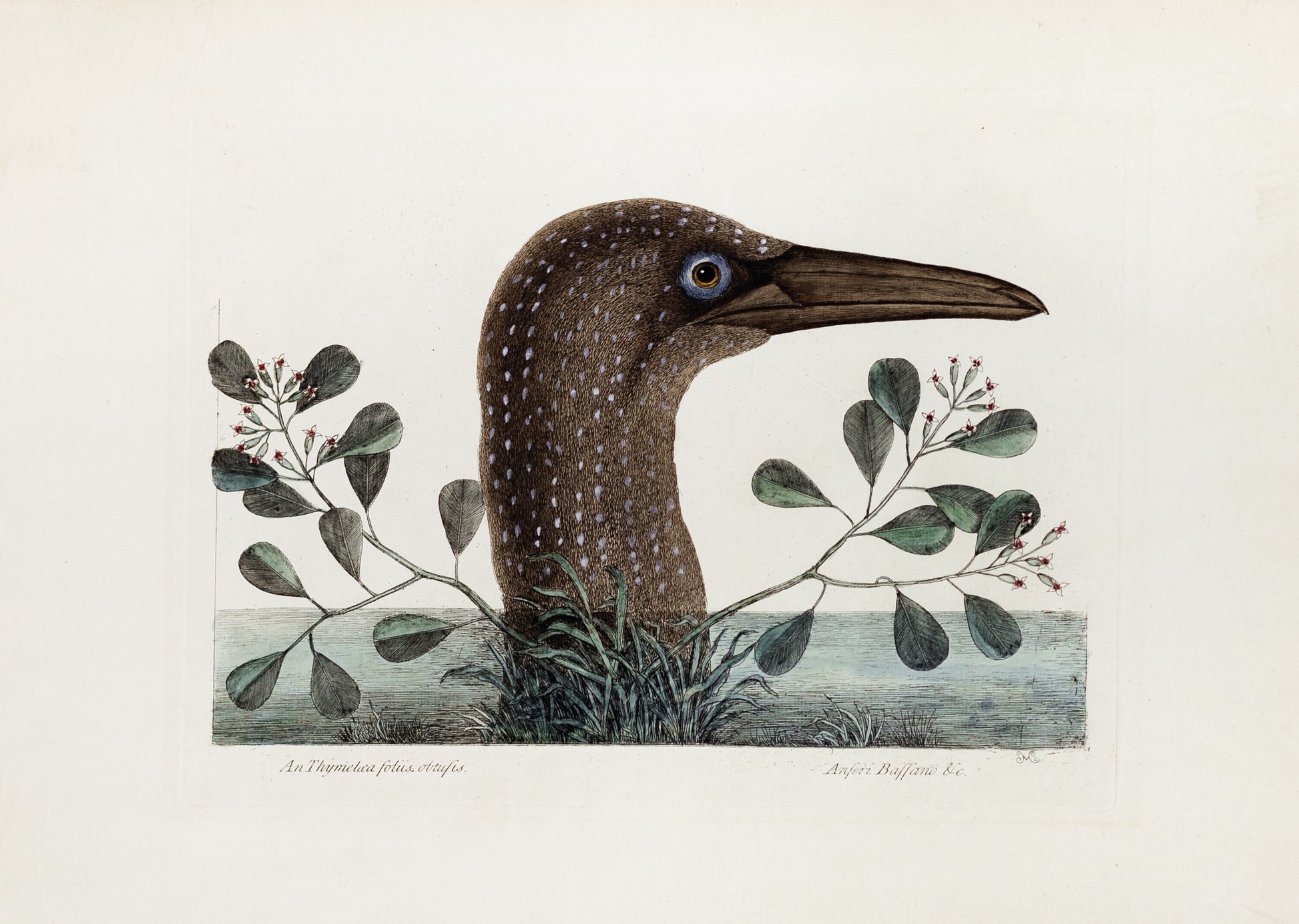Catesby, Mark. Vol.I, Tab. 86, The Great Booby
Catesby, Mark. Vol.I, Tab. 86, The Great Booby
Couldn't load pickup availability
Painted and etched by Mark Catesby (1638 - 1749)
Etching with hand color, paper dimensions: approximately 14 x 19 inches
From Volume I, Part 5 of Catesby's Natural History of Carolina, Florida & the Bahama Islands
London: 1732 - 1771
Currently known as the northern gannet, Morus bassanus and white mangrove, Laguncularia racemosa*, Catesby described these subjects as follows:
ANSERI BASSANO CONGENER Avis fluviatalis.
The Great Booby.
It's Size is about that of a Goose, the Head and Neck remarkably thick the Bill large, and almost Six Inches in length, a channel or cranny extends from one End to the other of the Upper Mandible. The Wings extended six Feet, and when clos'd, reach to the End of the Tail. The middle Feather of the Tail was longest, the Rest gradually decreasing in length, the Eyes are large, of a hazel Colour, encompassed with a Skin bare of Feathers. These Birds were of a dark brown colour, elegantly spotted with white on their Heads, the Spots are thick and small, on the Neck and Breast they are thinner and broader, and on the Back thinnest and broadest. The Wings are likewise spotted, except the large Quill-Feathers and the Tail, which are brown. The Belly of a dusky white. The Feet black, and shaped like those of a Cormorant. That which is most remarkable in these Birds is, that the Upper Mandible of the Bill, two Inches below the Angle of the Mouth is jointed, by which it can raise it from the lower Mandible two Inches, without opening their Mouths.
This Bird so nearly resembles the Booby (particularly in the singular Structure of the Bill) that I thought the Name of Great Booby agreed best with it. It frequents large Rivers, and plunges into them after Fish, in like Manner as the Booby does at Sea, continuing under Water a considerable Time, and there pursuing the Fish: And as as I have several times found them disabled and sometimes dead on the Shore, probably they meet with Sharks and other large voracious Fishes that maim and sometimes devour them. They frequent the Rivers and Sea Coast of Florida. The Colours of the Cock are brighter, and more beautiful than those of the Hen.
An Thymelaea foliis obtusis.
This Shrub riseth to the Height of eight or ten Foot, with a small Trunc covered with a whitish Bark, the Leaves are placed alternately on Footstalks, one third of an Inch long, narrow at the Beginning, growing broader and rounding at the Ends, two Inches long, and one over, where broadest of a shining Green, with one single Rib. The Flowers are tubulous, divided at Top into four Sections, they are white, except that within the Cup there is a faint Tincture of red, they grow in Bunches at the Ends of the Branches.
These Shrubs grow in many of the Bahama-Islands on the Rocky Shores amongst Sedge.
Mark Catesby (1683 – 1749)
Facts regarding Catesby’s early years are scant. It is known that he was born in the ancient market town of Sudbury, England to a father who was a legal practitioner and mayor of Sudbury and to a mother from an old Essex family. It seems that he received an understanding of Latin and French and was familiar with the eminent naturalist Reverend John Ray. Following his father’s death, he was endowed with the means to pursue his interest in the natural history of North America.
Catesby arrived in Virginia in 1712 as the guest of his sister and her husband, Dr. William Cocke, an aid the Governor of the colony. Soon he was acquainted with the well-connected William Byrd, a Fellow of the Royal Society whose diary contains passages discussing Catesby’s strong curiosity with all things relating to North America.
This included plants native to the fields and woods of Virginia through which Catesby traveled, collecting examples of botanical specimens unfamiliar in England, which he illustrated and sent back to his uncle, Nicholas Jekyll and the apothecary and botanist, Samuel Dale.
Catesby’s first trip to the New World was extensive and included a visit to Jamaica. Although he felt that his approach to a larger understanding of its natural history was lacking in structure, his experience would inform his future expeditions.
Following his return to London in 1719 Catesby resolved to return to the colonies and gather additional information for his illustrated Natural History... He gained the financial support of members of the local scientific community, many of who were members of the Royal Society keen to send a naturalist to Carolina who could provide an accurate account of its resources. Among those who belonged to the Royal Society was William Sherard, who after examining Catesby’s drawings, was key in advancing the project. With further backing by Sir Hans Sloane, court physician and naturalist whose collection would form the basis for The British Museum, Catesby sailed to Carolina in 1722.
Catesby’s four years of travels following his second arrival in North America brought him throughout South Carolina, parts of Georgia, and the Bahamas. He was
intent on visiting the same location at different times throughout the year in order to observe his subjects as they developed. In addition to gathering botanical specimens of potential horticultural importance, he also acquired birds and other creatures.
Catesby’s patrons in London were eager to receive examples of the varieties of plants and animals he encountered but collecting, packaging, and sending them back to England served as a distraction to his intended Natural History... Nevertheless, he continued to observe, paint, and write descriptions of the previously un-investigated wildlife he encountered on the shores and in the swamps, woods, and fields of the middle American colonies.
Catesby returned to England from his final voyage to America in 1726 and spent the next seventeen years preparing his Natural History... He envisioned his work containing colored plates reproducing his studies from nature in a substantial, folio-sized format, an achievement nearly unprecedented in earlier natural history publications. Catesby arranged for financing in the form of an interest-free loan from the Quaker Peter Collinson, a fellow of the Royal Society. Nevertheless, the cost of paying professionals to prepare his delineations on copper plates for printing was too great. To this end, with the assistance of Joseph Goupy (1689–1769), a French artist living in London, he taught himself to etch. In addition to producing nearly all of the plates for his publication, Catesby closely supervised the coloring of the engravings, either painting the impressions himself or closely overseeing the work to insure its fidelity to his preparatory work. To further finance the project Catesby sold subscriptions, offering his book in sections of 20 plates to be published every four months.
The first volume of Natural History of Carolina, Florida & the Bahama Islands, containing one hundred plates, was completed in 1731 and no doubt facilitated his election as a fellow of the Royal Society in February, 1733. The second volume, also containing one hundred plates, was finished in 1743 and was supplemented with twenty plates based on information sent to Catesby by John Bartram and others in in America appeared in 1746–1747. Of the approximately 180 - 200 copies of the first edition produced, roughly 80 copies remain complete and accounted for and there are an unknown number in private collections. A second edition was issued by George Edwards in 1754 and a third edition, published by Benjamin White, in 1771 who continued to print examples of the plates until at least 1816. As early as 1749 editions were produced for the European market with translations of the text in German, Latin, and Dutch. In these the plates for the first volume and appendix were re-etched by Johann Michael Seligmann and the plates for the second volume re-etched by Nicolaus Friedrich Eisenberger and Georg Lichtensteger.
Catesby’s tenacity resulted in a sweeping and compelling study of American plants, animals, and marine life native to little documented lands in which he strove to assign scientific nomenclature to his subjects. Indeed, Linnaeus, in his 1758 Systema Naturae, made use of much information brought to light by Catesby using it as the foundation of his system of binomial nomenclature for American species.
Throughout the production of his Natural History…Catesby lived in London with his Elizabeth Rowland with whom he had four children and married in 1747, before his death in 1749.
*From James L. Reveal’s Identification of the plants and animals illustrated by Mark Catesby for The natural history of Carolina, Florida and the Bahama islands in the appendix of The Curious Mr. Catesby, University of Georgia Press.


